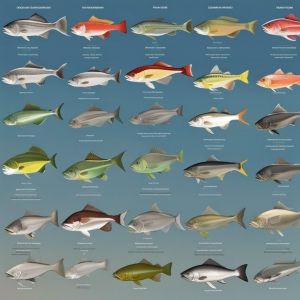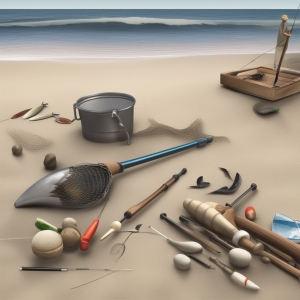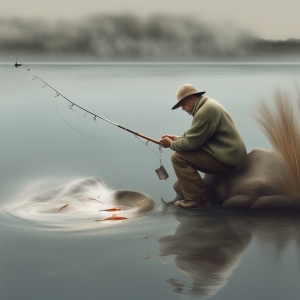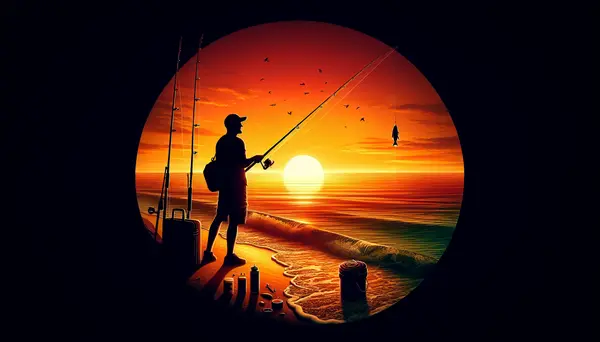Table of Contents:
In today's article, we are going to dive into the fascinating world of shore fishing. You might ask: What strategies and tactics can I use to achieve fishing success even without a boat? Here at Buzzerfish, we understand that not everyone has access to a boat, but that shouldn't limit your fishing adventures. We aim to introduce you to practical techniques and tips to enhance your fishing experience from the shore. This article will benefit both beginners and seasoned anglers looking to broaden their knowledge and improve their shore fishing skills.
Introduction to Shore Fishing
Shore fishing, as the term implies, refers to fishing from the coastline or bank of a water body, including lakes, rivers, and the sea, without the use of a boat. Oftentimes, shore fishing is the first exposure many get to the fun-filled world of angling. The beauty of shore fishing lies in its simplicity and accessibility - all you need is your fishing gear, patience, and a love for the great outdoors. However, mastering shore fishing involves understanding different techniques, bait choices, and knowing the best times to fish. Stick around, as we bring the world of shore fishing right to your fingertips.
Understanding the Basics
When embarking on your shore fishing adventure, it's important to understand the basics. While it might seem as simple as casting your line and waiting for a bite, a successful fishing experience requires a bit more attention to detail. First and foremost, you'll need the right fishing gear. This typically includes a fishing rod and reel, various sizes and types of hooks, fishing line of different strengths, sinkers of different weights, floats, lures, and bait. Last but not least, don't forget a fishing permit if your local laws require one.
Secondly, knowing your target species plays a crucial role. Are you aiming for fresh or saltwater fish? Each type of fish has its own habits and favorite meals which will help you choose the right bait and strategize your approach. Lastly, awareness of local regulations and catch-and-release ethic is a must. Remember, fishing should leave no trace behind—our aim should be to enjoy the sport while respecting nature and preserving it for future generations.
Comparison of Strategies and Tactics for Shore Fishing
| Strategy/Tactic | Pros | Cons |
|---|---|---|
| Surface Fishing | Easy to see if the fish hook because they bite near the surface. | Only effective for certain types of fish. |
| Bottom Fishing | Can catch a wide variety of fish, including those near the sea floor. | Requires more patience as it may take longer to attract fish. |
| Using Baits | Attracts more fish and increases the chances of catching. | Bait can be consumed without hooking the fish or may attract undesired species. |
| Lure Fishing | Various options to cater to different types and sizes of fish. | Lures can be expensive, and may get lost or damaged. |
Types of Fish and Where to Find Them

Before casting your line, it's essential to have an understanding of the different types of fish you can catch on the shore and their habits. The type of fish you'll find largely depends on the water-body you're fishing in. Freshwater bodies like lakes and rivers are home to species like bass, trout, and catfish. In contrast, saltwater bodies such as the sea or ocean can host a variety of species including sea bass, flounder, or mackerel.
Now, speaking of where to find them, a good rule of thumb is to look for places where fish might find food or shelter. Underwater structures such as drop-offs, weed beds, or rocky outcrops can be productive spots. Remember that fish have a keener sense of smell and hearing than humans, so stealth is key when approaching these potential hotspots. Lastly, keep an eye on the water's temperature and color - these factors might affect fish feeding and location patterns.
Fishing Tactics for Shore Anglers
Now that we're equipped with the basics, let's dive into some proven tactics that can enhance your shore fishing game. One of the first key things to remember is that patience is your friend. Patience allows you to observe water and fish behaviors and adjust your strategy accordingly.
Next, it's crucial to experiment with different casting distances. Don’t always cast as far as you can; sometimes fish are closer to the shore than you think. Also, consider different retrieval speeds. Your lure's speed can often trigger a fish's chase instinct, leading to a successful catch.
Additionally, bait selection is crucial. Live bait can be especially effective in shore fishing as it carries a scent trail that can attract fish. If you prefer artificial lures, choose those that best mimic local prey.
Becoming familiar with the tides is also necessary for successful shore fishing, particularly in saltwater bodies. Fish tend to feed more at changing tides; knowing when high and low tides occur can be a game changer.
Lastly, be aware of the weather. Fish are very much affected by changes in weather conditions. Warmer weather might make fish more active, while very sunny days might make them stick closer to deeper, cooler water.
Beneficial Tools and Equipment

Aside from the basic fishing gear mentioned before, there are additional tools and equipment that can significantly enhance your shore fishing experience. One of the most important is a quality pair of waders. These waterproof boots allow you to step into shallow water to extend your reach or to retrieve your catch. They're particularly beneficial when fishing in areas with rocky or uneven bottom conditions.
Another excellent tool is a tackle box. This compact and organized container can hold lures, bait, lines, and all sorts of small fishing gear. It's a surefire way to keep your fishing equipment in order and easily accessible.
A fishing chair, though not a necessity, can hugely improve your comfort during those long waiting periods. Some fishing chairs also come with additional features like rod holders and cooler pockets to store your bait or catch.
Investing in a reliable hook remover or disgorger can also prove worthwhile. It can help you release a fish more quickly and safely, causing less harm to both you and the fish.
Lastly, a pair of polarized sunglasses is beneficial, especially for daytime fishing. They enable you to see beneath the water surface, cut out glare, and protect your eyes from harmful UV rays.
Choosing The Right Bait
Selecting the right bait is one of the most important aspects of successful shore fishing. When choosing your bait, there are two main options - live bait and artificial lures. Live bait, like worms or minnows, is often the go-to choice for many anglers. The natural scent and movement of live bait is extremely effective at attracting fish.
On the other hand, artificial lures, such as spinners, spoons, or soft plastics, can be equally productive. Lures are especially useful when angling for predatory fish, as their movement triggers the fish’s hunting instincts. It's crucial to understand the behavior of the fish species you're targeting to choose the most effective bait.
For instance, if you know the fish in your particular water body favor small insects, using insect-like lures or actual insects as bait can prove successful. Similarly, if larger predatory fish are present, bait that mimics smaller fish could yield a catch. It's all about understanding the feeding habits of fish and adapting your bait selection accordingly.
Ultimately, the best strategy often involves a combination of both live bait and lures. This way, you can attract a range of fish species, increasing your chances of a successful fishing day.
Reading the Water: A Key Factor

One of the most vital aspects of successful shore fishing is the ability to 'read' the water. Like a good book, water bodies have their distinct stories to tell. Learning how to decipher these is key to unlocking a significant advantage in shore fishing.
'Reading the water' helps you to spot signs of fish activity, understand water current patterns, detect underwater structures, and identify possible hiding places for fish. When you know how to read the water, you'll know where your bait should land to increase your chances of a catch.
For example, observing where birds are diving can give you an indication of where schools of smaller fish, and subsequently, larger predatory fish, may be located. Also, spotting jumping or stirring fish can be an excellent sign of active feeding, making it potentially a good spot to cast your line.
Understand that different water conditions and current structures make certain areas more attractive to fish. While there may be no exact science to perfectly reading the water, developing this skill through practice and close observation can give you a significant edge in shore fishing.
Weather Conditions and Seasonal Fishing
It's widely known among anglers that weather conditions and seasons play significant roles in fishing activities. Firstly, understanding how weather impacts fish behavior can give you a huge advantage. Fish are cold-blooded creatures; they rely on external sources to regulate their body temperature. This means the water temperature directly influences their feeding and breeding habits. Cooler temperatures often lead to a decrease in activity, while warmer temperatures tend to increase feeding.
As for the effect of seasons on fishing, each has its own unique characteristics. In spring and fall, when water temperatures are moderate, fish tend to be more active and can be found in shallower waters. During the winter months, fish tend to move deeper into the water where temperatures are warmer. In the summer when the water surface heats up, you might find them in areas with shade or deeper waters. Each season requires different strategies for successful shore fishing.
Additionally, it's important to remember that fish are highly sensitive to changes in barometric pressure—an increase in pressure often results in a decrease in fish activity, making fishing more challenging. Adjusting your tactics in line with weather conditions can dramatically improve your fishing success, so always check the weather forecasts before heading out on your fishing expedition.
Advanced Shore Fishing Strategies
While the above tactics can greatly improve your success in shore fishing, for those ready to step up their game, there exist advanced techniques that can turn an ordinary fishing trip into an extraordinary one.
First off, mastering the art of reading the water can give you an edge above others. Examining the rippling effects on the water surface can help you identify underwater structures and potential fish hideouts. Look for areas where the water changes direction or current, these areas often attract fish.
Next on the list is night fishing. Some fish species, particularly those in saltwater bodies, become active at dusk and throughout the night. Pay close attention to safety and use a good headlamp to keep your hands free for fishing.
Another not so obvious, but equally important, skill to possess is the ability to interpret bird behaviors. Birds like seagulls, terns, or cormorants can be great indicators of where the fish are. If you see a flock of these birds diving in a particular spot, chances are high that there's a school of fish underneath.
To finish off, adopting the technique of chumming, or groundbaiting, can attract more fish to your area. This involves throwing bait into the water to arouse the fish's senses, making them more likely to bite your hook. It's important to note that in some areas, chumming might be regulated or even prohibited, so double check the local fishing rules before practicing this method.
Conclusion and Key Takeaways
In summary, shore fishing is both an accessible and enjoyable way to experience the thrill of angling. While it may not require a boat, it does demand a good understanding of the basics and the application of effective strategies and tactful means.
From knowing your target species, choosing the right location and understanding the behavior of fish to using suitable bait and equipment, we hope these strategies and tactics we’ve shared will boost your confidence and skill in your next shore fishing adventure.
Remember, success in fishing doesn't solely lie in the size and quantity of your catch, but also in the gratification of being in nature and the thrill of the challenge. As you refine your skills and invest more time in this hobby, you may just find that shore fishing delivers surprises far beyond what you imagined. Keep casting, stay patient, and enjoy every moment on the water's edge! Here at Buzzerfish, we're always here to guide and support you in your angling adventures. Good luck and tight lines!
Frequently Asked Questions about Shore Fishing
What are the basic tactics for shore fishing?
The essential tactics include selecting the right gear, knowing the behavior of the fish you're targeting, understanding the water conditions, and using the appropriate bait and lures.
What time is best for shore fishing?
Dawn and dusk, when light levels are changing, are often the best times for shore fishing, as many fish are most active during these periods.
What type of fishing equipment should I use when fishing from the shore?
This can depend on the type of fish you're targeting and the specific location, but generally, you'll need a good fishing rod, a strong fishing line, and the right bait or lures.
Is shore fishing easier than boat fishing?
Both have their own challenges. Shore fishing can sometimes require more strategies, as you may need to scout out locations for optimal fish population. However, it's more accessible and can be just as rewarding as boat fishing.
Can I catch big fish when fishing from the shore?
Absolutely. Many large species of fish come close to the shore, and with the correct approach and equipment, you can have successful catches. Patience and understanding your chosen location is key.







